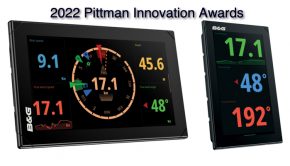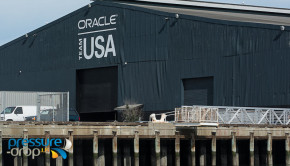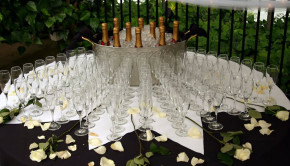Stan Honey – Diary of a Navigator
Published on February 27th, 2010
 Photos courtesy of Cammas-Groupama.com
Photos courtesy of Cammas-Groupama.com
Navigator Stan Honey (USA) is among the nine crew sailing with skipper Franck Cammas onboard the 103-foot maxi trimaran Groupama 3 during their attempt to win the Jules Verne Trophy, a fully crewed round the world record attempt under sail. The current record holder is Bruno Peyron and crew, who in 2005 sailed Orange 2 to a time of 50 days, 16 hours, and 20 minutes at an average of 17.89 knots. Posted below are reports that Stan has provided to Scuttlebutt during Groupama 3’s record attempt.
November 10, 2009
Stan: Our decision to depart on November 5th was a decision to accept an initial setback at the start of the passage. The sea state was so rough and the sailing angles so close that we knew that we would have a slow and rough first night. We were right. On the other hand our objective in leaving then was to get good conditions for the rest of the trip to the equator. So far we are getting what we had hoped for with a simple trip to the doldrums being able to take a one gybe course that kept us well clear of the Canaries and Cape Verde Islands. Crossing the doldrums between 29 and 30 W seems to be working for us.
Before finalizing a departure decision you also scrutinize the St Helena high and the South Atlantic to make sure you are not sailing into an impassible wall. The forecasts are too far out to have much certainty on the S. Atlantic at the time of one’s start, but you still try. Having a Guardian Angel named Sylvain Mondon at Meteo France is a big help to me. I wish I had such an Angel during the 2005-6 Volvo Ocean Race I navigated on ABN AMRO.
I came down with a mystery massive headache on the day after our start. No, it wasn’t a Whisky hangover . Fortunately it went away entirely last night. I was always able to do my work but it was very painful for a while.
Note: Groupama 3 must cross the finish line off Ushant, France before December 26th at 08:09:26 (UT) to set new record.
November 16, 2009
It was at 1216 UT that the skipper of the 103-foot trimaran Groupama 3, Franck Cammas, called the Jules Verne Trophy team to inform them that an aft beam bulkhead had broken, leading to serious damage to the float. Groupama 3 headed towards Cape Town some 1,700 miles away (3,000 km), arriving on November 21st to repair the beam so that another JV attempt could commence by January 2010.
January 31, 2010
Franck Cammas and his nine crew on the 103-foot triamaran Groupama 3 set off today (13:55:53 UTC) at over twenty knots, crossing the start line off the Créac’h lighthouse in Ushant, France in their attempt to establish a new time for the Jules Verne Trophy for the fastest circumnavigation of the world by any type of yacht with no restrictions. They will need to finish off Ushant before March 23rd (06:14:57) to snatch the record from its current holder Bruno Peyron and crew, who in 2005 sailed Orange 2 to a time of 50 days, 16 hours, and 20 minutes at an average of 17.89 knots.
February 3, 2010
When it was decided to go, how far down the track could you forecast the weather pattern?
Stan: Generally, at departure, you can get a good forecast of the trip to the equator and can get only a very general view of the structure of the weather in the South Atlantic. So you want a departure time where you won’t likely be blocked in the South Atlantic and that has a reasonable time to the equator.
With the imperfect weather at time of start, was there a plan to abort if you were a certain distance behind the reference time?
Stan: The North Atlantic trip was risky, especially regarding whether if we started after the low passed at Ushant, would we get past Cape Finisterre before the High moved E and shut down the wind? The calculations indicated that we would just make it. If we did make it, it was a very attractive forecast to the equator; possibly the second fastest in history. If we had been stopped at Finisterre it would have been so early in the trip that it would have made sense to return.
For routing issues, which part of the track poses the greatest obstacles?
Stan: Normally the riskiest part is the South Atlantic because at the start, the forecasts are so far out and so are much less reliable. In our November 5 start, we had almost no risk in the North Atlantic, and the usual weather risk in the South Atlantic. As it happened the weather came out fine and it looked like our trip to the longitude of Cape Town would have set a record had we not been forced to stop. For this departure on January 31, we started on an attractive but risky pattern for the North Atlantic, but we have successfully passed the risky part of the North Atlantic passage.
How far ahead can you see now, and how is it looking?
Stan: Weather models are quite good for three days, reasonably good out to six days, and increasingly dicey beyond that. We have substantial risk remaining in the South Atlantic. However, we are glad we started when we did and we are happy to be here. Waiting around on standby is one of the hardest things for sailors.
February 11, 2010
How does the team feel about this attempt so far?
Stan: We left for this Jules Verne Trophy attempt on a weather pattern that was risky near Cape Finisterre, not long after the start, and then had significant risk of being slow in the South Atlantic. With the limited time in our team’s schedule it appeared to be the last departure opportunity left for us. Our hope was (and is) that we could get to the Cape of Good Hope within a half day of Orange 2’s record time. We still might be able to achieve that with some luck.
In hindsight it was good that we left because it turns out there were not any subsequent departure possibilities within the time that would have worked for Groupama’s other commitments.
How typical are the weather challenges right now in the South Atlantic?
Stan: This passage through the South Atlantic has been very challenging due to the large St Helena High, and the new High joining it coming from the SW. It has been my lightest and slowest passage in the South Atlantic. It reminds me of the Transpac in 1979, navigating the appropriately named yacht, Drifter.
The Southern Hemisphere SE trades have been unusually light this year. But it does not take much wind for these big multihulls to make good speeds so we were happy with our passage through the SE trades. The tough part of our passage to the Southern Ocean Westerlies has been passing through the “Horse Latitudes” that are between the SE Trades and the Westerlies. In fact we are still struggling to get out of the St Henena High and exit the Horse Latitudes.
How do the Southern Ocean Westerlies currently look?
Stan: The outlook for the Westerlies in the South Atlantic and Indian Ocean is very good. We just need to get to them.
How will Groupama 3 overcome the current record?
Stan: Having inspected Orange 2’s track, I suspect that Groupama is a few percent faster than Orange 2. When Bruno Peyron and his crew on Orange 2 set the current record in 2005, they had extremely impressive passages in the South Atlantic outbound, and then in the Pacific. We gained on Orange 2 in the North Atlantic, and will lose substantially to Orange 2 in the South Atlantic, although we still might come close to our goal of being within a half day of Orange when we pass the Cape of Good Hope. We are unlikely to be able to better Orange 2’s time in the Pacific due to their terrific passage there. So to beat Orange 2 we will need to be reasonably close at the Cape of Good Hope, make gains in the Indian Ocean, and gain in the Atlantic on the way north to the finish line off Ushant, France.
February 19, 2010
The main focus is the Jules Verne Trophy, but are there other goals?
Stan: Setting a Jules Verne Trophy record is the team’s objective. It is my personal objective as well, although having the opportunity to sail with these guys on this boat is terrific apart from the JV.
There is a balance between maximum speed and caring for the boat and crew. What are the factors that dictate the decision on how hard to push?
Stan: Sea-state is almost always the reason when an offshore multihull has to throttle back. For that reason, the consideration of sea-state is critical in course selection. Tactique, one of the routing programs that I use, allows me to create a data model describing the performance impact of swells, windwaves, and cross sea. The performance impact varies with swell size, angle, and the size and cross angle with wind waves. Tactique uses that model in conjunction with the polars in the calculation of routes.
On this attempt we have been fortunate with sea-state and have not throttled back. On the other hand, we had a very difficult weather pattern in the South Atlantic and lost 1000 miles there due to light air.
On our first Jules Verne attempt starting in November 2009, we slowed for sea-state for much of the first 24 hours, but still had the fastest ever passage to the equator.
Given that the 33rd America’s Cup was a multihull event, was the Groupama 3 following the event?
Stan: The Cup was of great interest to the crew, and we managed to watch parts of it onboard via Inmarsat. Sylvain, our meteorologist at Meteo France, also sent along highlights by text chat.
The team was divided. Franck and some of the guys had worked with BMW Oracle and so had a history there. Stève Ravussin is Swiss, and so was a (very) outspoken Alinghi fan. The guys assumed that I would be an Oracle fan as an American. I loved watching the two amazing boats race, but I have been cheering for the clock, and have just wanted the 33rd Match to come to an end as quickly as possible. (Editor note: Stan has also been working with TeamOrigin).
February 27, 2010
What tools do you use to track icebergs, and how has their position affected your tactical decisions?
Stan: We have been using a French radarsat processing company, CLS, to process satellite radar scans of specified areas for us. However, there is still risk as small icebergs and growlers smaller than 50m or so cannot be tracked from space.In addition we use Australian and other sources of data on known icebergs. Finally we use historical data on past iceberg locations, both from previous sailing events in the Southern Ocean as well as statistical data like that found on Pilot or Routing charts. The Southern Ocean is tougher than the North Atlantic where there is an ice tracking organization with a long history.
We stayed north of a field of icebergs that was South of Australia. As it turned out, that was not much of a detour. In the Pacific we might have gone further south at times if we had certain knowledge that there was no ice. On the other hand, big multihulls don’t need as much wind as the Volvo 60’s used to, and therefore we do not have as big of an incentive to sail far south the way the 60’s did.
What kind of collision damage can Groupama 3 sustain and be able to continue on?
Stan: Collisions are a concern. My impression is that one boat in ten that circumnavigates in a race or record attempt will sustain sufficient damage at some point during the event to affect the boat’s performance, e.g. lose or damage an appendage or damage a false bow.
It is difficult to track floating objects in high sea-states. The return from the rough surface of the sea creates lots of clutter that can mask the radar or sonar return from a growler or other small object floating amid the waves. This sea clutter masks the return from small floating objects whether those objects are scanned from above with radar, or from below with sonar. On other projects I have used infrared imaging to detect ice with limited success.
Like most boats that race around the world, Groupama 3 has false bow(s). Nevertheless, a sufficiently severe collision would disable the boat. Also, we do not carry spare appendages.
March 3, 2010
As you approach Cape Horn, what’s the strategy to round this notorious landmark?
Stan: Sometimes rounding the Horn can be a cakewalk in shirt-sleeve weather. We may get reasonable weather for our upcoming rounding.
On the other hand, when the weather is bad, it is often very bad just west of the Horn. The weather improves quickly once the Horn is passed.
One guideline is to approach the Horn from due west. It is particularly dicey to approach the Horn from the NW. If you get a windy northwesterly, then it is particularly windy NW of the Horn because of the ducting along the mountains. If you instead get a windy southwesterly and are approaching from the NW, you may have trouble laying it, and you’re on a lee shore.
Unless your timing is perfect to pass west of a low coming off the mainland, I prefer passing well South of the Horn, and well outside of the Falklands. It is often light between the Falklands and the mainland. Staying a bit longer in the westerlies can provide some very inexpensive easting that you will need eventually before the equator.
March 16, 2010
Watching your progress online from Cape Horn to the equator was brutal. Could the conditions have been much worse?
Stan: In principle it could be still worse, but I have never seen it worse than what we had.
How much could you rely on your weather tools to make strategic decisions, or were you dealing more with your onboard observations?
Stan: Of course you race in the wind that you’ve got, which often varies from what the forecast predicts for the current time. One of the most important skills in navigation is dealing well with this discrepancy.
The right answer is to use your observations for the current time to correct the forecast, but blend out those corrections over time. The error in the forecast is often due to a weather system that is moving at a different speed or direction to that forecast, or due to a mesoscale feature that is not reflected in the forecast.
In the present, your onboard observations are perfect and certain, and you need to race in the wind you’re in. But in the long term you HAVE to bet on the forecast. The forecast is not always right, but if you instead play hunches, your competitors who use the forecast well will crush you.
Your team reported countless maneuvers in the South Atlantic to negotiate the various weather obstacles. What is the process onboard for making those decisions?
Stan: Everybody was working hard. In some cases the timing of a tack or gybe is a major strategic decision. In other cases the directions to the on-deck watch is to tack or gybe on the shifts, sailing whichever board is favored relative to a specified wind direction.
Groupama 3 is tactically much more nimble than a Volvo Ocean Race boat. On a VOR boat it takes the entire crew 30 minutes or more of hard labor to tack (or gybe) and then completely restack the boat. On Groupama 3, after a tack or gybe the standby watch can be back in their bunks in ten minutes and the off-watch can sleep through it. So it is much easier to navigate Groupama 3 than a VOR boat where a decision to tack too early can be devastating to the crew as you may need to tack back, and end up doing three tacks with 30 minutes of hard labor stacking, instead of one.
I don’t want to jinx you, but the weather seems favorable now.
Stan: Good idea not to jinx us now, thanks. We can’t see all our cards quite yet.
What are the hurdles that remain before Ushant?
Stan: We have to cross the ridge of the Azores High, then we have to find our way through a rapidly changing and complex Westerly flow. There will be spots of too much wind, risks of dropping back into the trailing ridge, sea-state problems West of the cold front, and concerns about Finisterre becoming a lee-shore. If we could stack the deck, we would get a broad SW flow with the normal flat sea-state of a SWly, associated with a system that was moving at a speed that we can match, and that would take us directly to Oessant. We got that (corresponding Southern Hemisphere condition) in the Indian Ocean and early in the Pacific, but not since.











 We’ll keep your information safe.
We’ll keep your information safe.